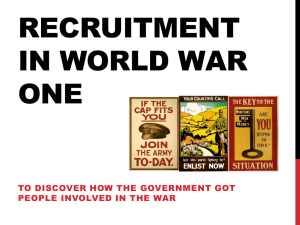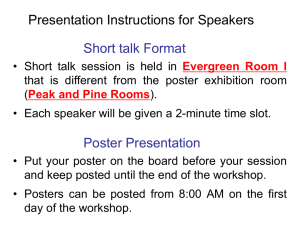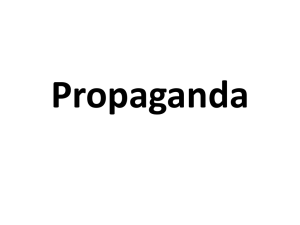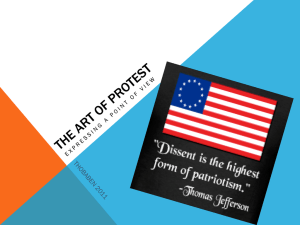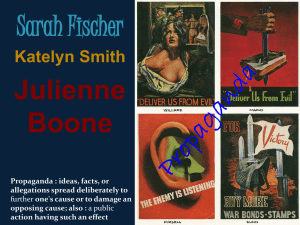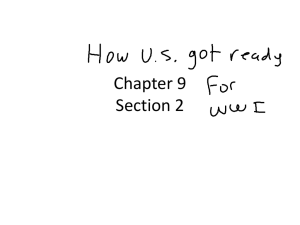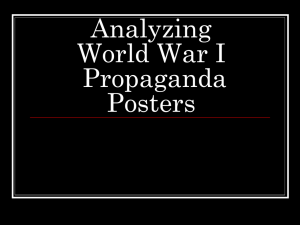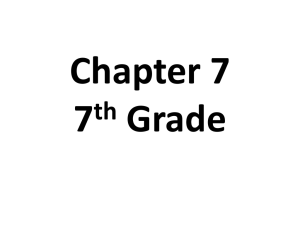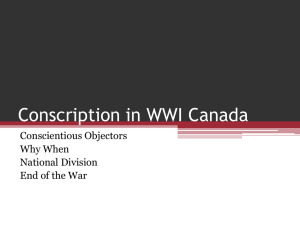Modern Assignment completed - History
advertisement
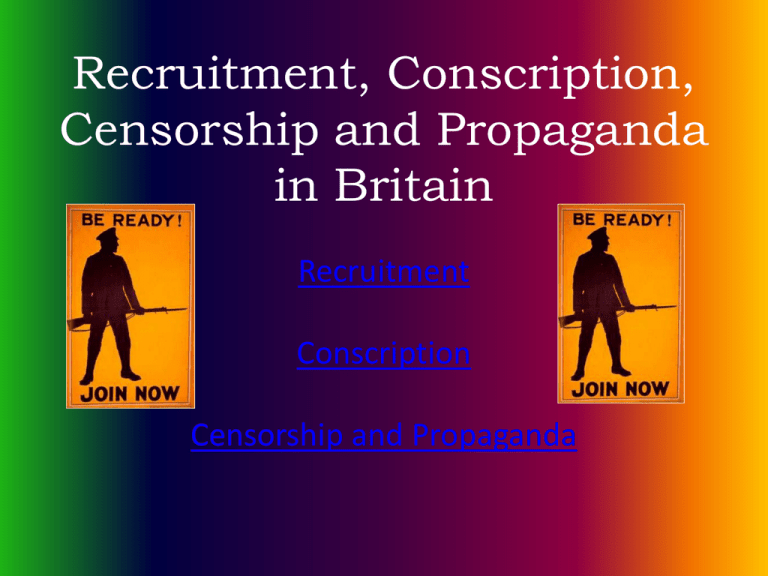
Recruitment, Conscription, Censorship and Propaganda in Britain Recruitment Conscription Censorship and Propaganda Recruitment Recruitment is the enlistment of volunteers to fight in their country’s army. During the early months of the war recruiting committees were established all over Britain and had little problem encouraging men to join. By mid-November 1914, 700 000 men had volunteered, and by January 1915 that number had risen to over 1.34 million men. As competition to enter the ranks became tough, enlistment rates fell dramatically thus recruitment campaigns became more radical. Sports clubs and professional football association were used effectively to promote recruitment, as was war propaganda. Britons Wants You: Join Your Country’s Army Lord Kitchener (pictured) was the Minister of War and featured on early recruitment posters to encourage men to defend their country and participate in the war. This poster was a prominently used and well known recruitment poster which influenced the decision of many man to join the army. This poster appealed to men’s patriotism individually and made them believe they could make a difference and help their country and families. It is of the perspective of a British Recruiting Office which uses Lord Kitchener’s authoritative influence for recruitment. Source: Webb,K -World War 1: From Sarajevo to Versailles Wanted at the Front: Enlist Today This poster is appealing to the men’s pride and patriotism for their country and their want to defend their land and king. The flag demonstrates the patriotism and the lines of men embarrass the other men in the crowd as they aren’t doing anything to help. This poster deals with needing more men at the fighting front and trying to motivate them in to helping their bit. The poster is inclusive and personal and would have made men think about why they haven’t joined up and then changed that. The perspective of the poster is of a soldier or higher army general who need more men to enlist. Source: http://library.georgetown.edu Women Of Britain Say- ‘Go’ The ‘Women of Britain Say- Go’ poster was a popular recruitment poster as it appealed to women to encourage their brothers, husbands, male family members to enlist in the war. It was an effective poster as the women did encourage the men to enlist and the men who didn’t would be embarrassed and ashamed as they were called a coward and given a white feather to symbolise this. The women and young boy in this poster are looking to the soldiers in admiration as they go to defend their country. This would appeal to the men and they would want women to admire them also. This source is of the perspective of women of Britain, telling the men in their lives to go to war and do their bit for Britain. Source: http://library.georgetown.edu Recruitment Poster: Who’s Absent This recruitment poster is direct and personalised. It is aimed at the men who hadn’t volunteered to fight. The pointing finger is accusing, as is his stare, and is designed to be direct and bring shame to the men who hadn’t joined the army. The poster demonstrates British pride and patriotism and is eluding that not joining the army is proving that you aren’t patriotic. The perspective of the poster is that of the British army appealing to men to enlist in the army. Source: http://quadri.wordpress.com/-propaganda-in-the-first-world-war/ Conscription Conscription is the forcible enlistment of men into the armed services. In Britain the voluntary recruitment system had reached its limits by early 1915. The Director of Recruitment, Lord Derby, introduced the Derby Scheme which aimed to boost numbers dramatically, but failed and was closed in December 1915. In May 1916, conscription was introduced in Britain with the Second Military Service Act whereby all men were liable for service. Extending Conscription Report This source is an extract from a government report on the possibility of extending conscription to married men. It demonstrates means that were taken as apart of the First Military Services Act of 1916. Conscription became necessary when recruiting numbers fell dramatically. This source is explaining the fall in numbers and the need for conscription to start to raise the number of soldiers once again. This source is of the perspective of the Army generals who need more soldiers. Source : http://www.learningcurve.gov.uk/britain1906to1918 Conscription Poster This poster is directed at men who hadn’t enlisted willingly already at the beginning of the war. It provides details on enlistment and conscription at that time and where to go to signup. The use of Lord Kitchener again emphasises his authoritative influence. It is of the perspective of Britain army and recruiting office, appealing for more men. Source : http://pierreswesternfront.punt.nl To Arms! This poster demonstrates Britain’s desperate need for more men in the army as they begin to appeal to all men. It displays the amplified need for conscription as there wasn’t enough men enlisting. It demonstrates that the British government had a shortage of men and there attempts to replenish the army. It is of the perspective of the British army/government who need more men to join the army. Source: http://libcom.org/files/images/ Anti-Conscription Petition The perspective of this source is that of the British conscientious objectors who are opposed to the idea of forcing men to join the army. Conscientious objectors are an important part of understanding conscription because there will always be people who object to being forced into things. Source : http://www.nationalarchives.gov.uk/ Censorship and Propaganda Propaganda is the deliberate presentation of a one-sided view or argument of an issue. Its aim is to convince an audience of a particular point of view, mainly those of the composer. The British used propaganda for many purposes in World War 1 in particular to promote voluntary enlistment, to create hatred of the enemy, to encourage women to take on war work and to gain support of neutral states. Censorship is negative propaganda. The aim of censorship is to prevent the other side of the issue being presented and to limit what the public hears about a situation. Women of Britain This form of propaganda is aimed at women to encourage them to do their bit in the war effort. At the home front in Britain, women were being encouraged to help out in the workforce to help supply resources to the soldiers. This poster appeals to women to enrol in the work force and help out. This poster is an example of the different types of propaganda that was used in the First World War. Not only was there recruiting posters but also censorship and home front propaganda. It is portrays women as being empowered by getting factory jobs and helping out in the war effort. Giving them a sense of inclusion and accomplishment. It is of the perspective of patriotic factory owner’s wanting women to work in their factories to help with the war effort. Source: www.st-andrews.com.uk Recruitment Propaganda This poster was a significant recruiting poster as it displays a sense of shame in the man’s face when his children asked him what he did to help out during the war, and he didn’t do anything at all. This sense of shame would have been a driving force to join as they didn’t want to have that same shame when asked what they did. The young boy playing with soldier figurines demonstrates that the war is a major part of society and should be important to everyone. It is of the perspective the little girl, asking her daddy what he did to help out. This will help appeal to men as they don’t want to be embarrassed. Source: http://quadri.wordpress.com British Propaganda: How The Huns Hate This source is an example of one of the many atrocity stories that were being spread throughout Britain. These stories painted the Germans as horrid monsters , Huns, that committed crimes against men, women and children and they needed to be stopped. These stories scared the public and made it easier for people to hate the Huns and to want to go to war and stop them. This poster is of the perspective of a British army member who ‘witnessed’ this incident and is appalled by the atrocities that were committed against one of their men by the Huns. It is warning the public to be aware and realise that they need to stop the Huns before they get more dangerous. Source: http://quadri.wordpress.com Censorship Propaganda This British Propaganda poster promotes the idea of secrecy and security when it came to talking about the British war situation. The poster gives an inside to the paranoid feeling during the war of not only the government, but also the public who had a genuine fear of the Germans. Censorship increased during the war for numerous reasons being that the government didn’t want their secret tactics revealed to the Germans. Also the government didn’t want the public to see the true horrors of war that the soldiers faced, which would have led to large opposition to the war and a decline in volunteers. The poster is of the perspective of paranoid and cautious army members at the Ministry of Information who didn’t want important information to be leaked to the enemies. Source: http://www.st-andrews.ac.uk
